With a coastline stretching 367 miles, Texas has no shortage of saltwater fishing opportunities. And that extends to anglers looking to catch the coveted Red Snapper. Unlike elsewhere in the country, you can go after this trophy species year-round, and there are plenty of them on offer.

In this article, I’m going to cover Texas’s Red Snapper fishing opportunities. I’ll explore where to go, when to visit, and what to expect. Let’s dive in.
Where to Fish for Red Snapper in Texas
Red Snapper fishing in Texas can be divided into two main fisheries: fishing in state waters and fishing in federal waters. State waters are all waters that extend out 9 nautical miles off the coastline. Federal waters extend out from the state water boundary – starting at 9 nautical miles and beyond.

It’s very important to understand the difference between these two “fisheries” because the rules, regulations, seasons, and slot limits vary significantly.
State Waters
Perhaps the most popular and appealing thing about Red Snapper fishing in Texas is that the season is open year-round in state waters. This means that Texas anglers can pursue, catch, and keep Red Snapper all year, as long as they are fishing within state waters. And, there are plenty of Red Snapper to within that range – if you know where to look.
Federal Waters
The Red Snapper fishery in federal waters off the Texas coast is managed by the National Marine Fisheries Service. Each year, the season, along with bag and size limits, changes for recreational anglers.
Typically, the federal Red Snapper season is much more conservative, with a short season and smaller bag limit. However, the majority of the truly big Red Snapper are caught in federal waters.
How to Tell If You’re in State or Federal Waters
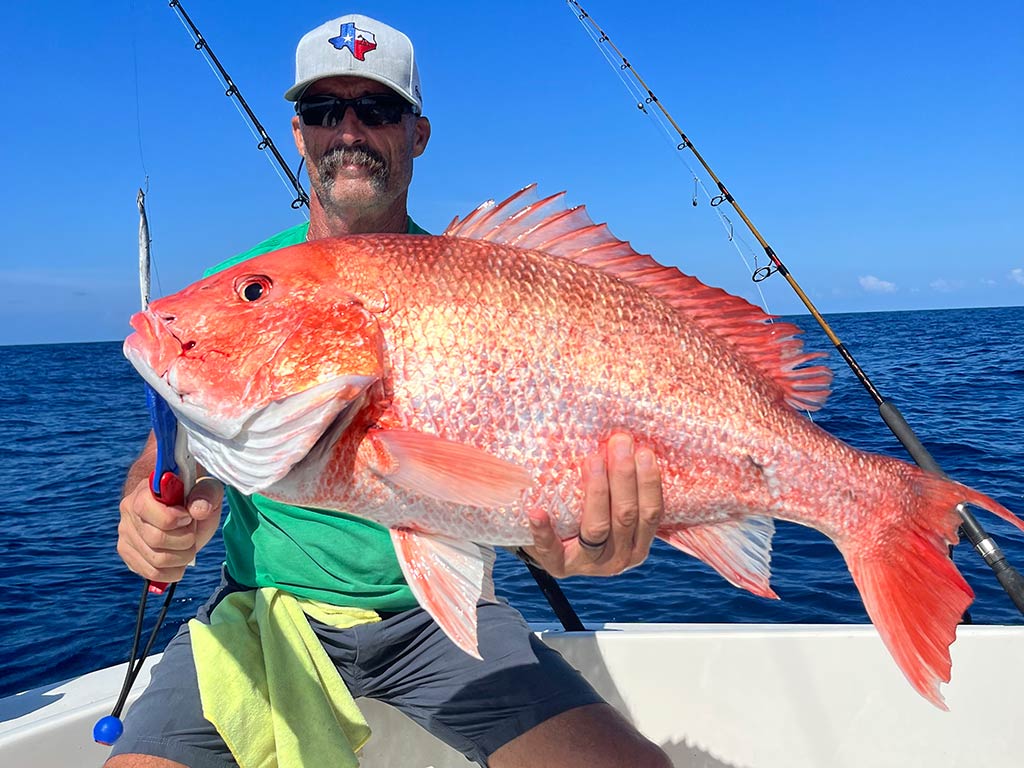
The easiest way to determine if you’re fishing in state or federal waters is to use an electronic navigation device and mapping software. Most marine electronic units will have navigation charts and boundary markers, so you can see precisely where you’re fishing – i.e. in state or federal waters.
Additionally, marine charts and navigation maps also indicate state/federal boundaries. When planning your trip, determine your desired fishing area and confirm the location before departing.
Best Texas Ports for Red Snapper
All of the major cities along the Texas coast offer access to Red Snapper fishing grounds with experienced guides and charter captains ready to put you on the fish.
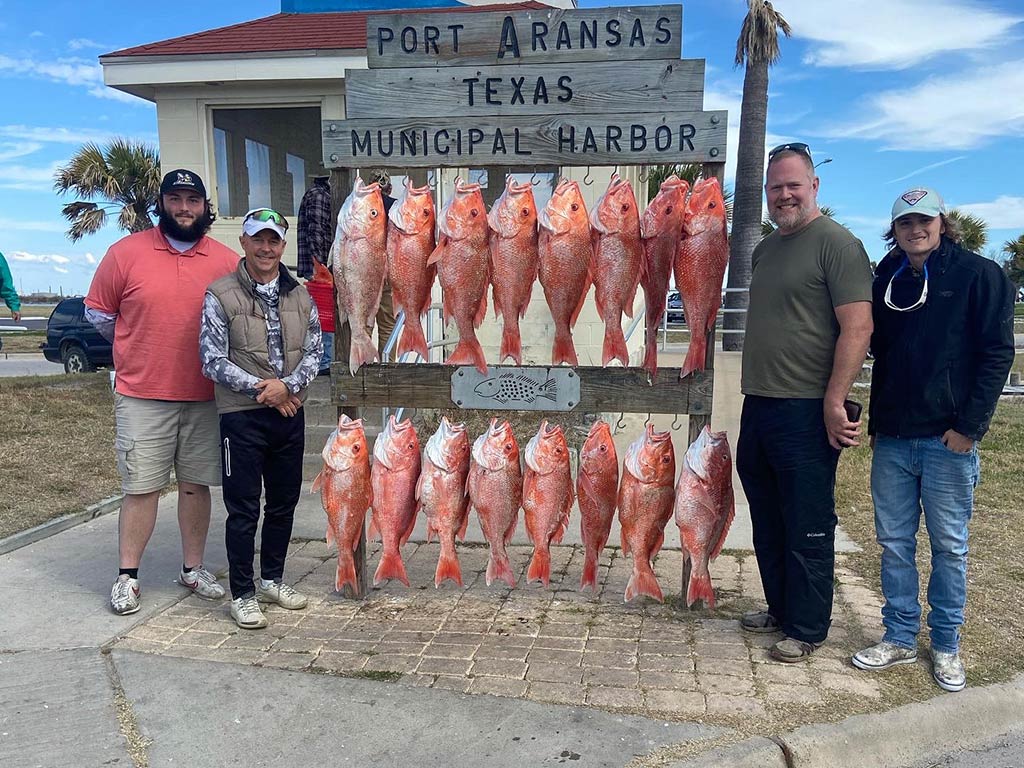
Determining where to plan your trip depends on your (or a captain’s) vessel and the time of year. For example, Port Arthur and Galveston in North Texas have excellent Snapper fishing. However, the majority of the opportunities are going to be in federal waters, due to the shallow depths found in state waters.
As you move down the coast to Port O’Connor and Port Aransas, deeper waters are much more accessible, with numerous artificial reefs and wrecks found within state waters in 50–80 feet, making them ideal for smaller vessels and close access.
And although South Texas doesn’t get as much attention for its Red Snapper fishing opportunities, it would be a mistake to miss out on it. South Padre Island has three reefs within its state waters. It also offers the quickest access to the continental shelf, where the chance of catching a true deep water giant is possible.
Red Snapper Habitat
Red Snapper is a bottom-dwelling species, found off the Texas coast in 30-600 feet of water. They prefer hard structure with relief – so keep an eye out for reefs, rocks, rubble, ledges, or any other hard bottom, such as sloping limestone banks and mixed coral.

If it’s your first time fishing for Red Snapper, consider hiring an experienced guide or charter vessel. They have the experience and local knowledge to put you on spots that don’t receive a lot of fishing pressure.
Artificial Reefs
Thanks to the efforts of the Texas Parks and Wildlife Department, there are dozens of artificial reefs found off the Texas coast where you can catch Red Snapper and many other popular species.
Take a look at the Texas Artificial Reef Interactive Mapping application where you can get the exact GPS locations of artificial reefs in your area, along with the depth, distance from port, and much more.
Natural Reefs
You don’t need an artificial reef to find Red Snapper in Texas. In fact, there are countless natural reefs and prime habitats scattered along the Texas coast that hold fish.
Grab a local chart of the area you intend to fish or use the electronic navigation device on your vessel to scan and look for Red Snapper habitat indicators, such as hard bottoms, rubble piles, debris, and reefs. These natural habitats may take some homework to find, but they can be incredibly productive.
Oil Rigs
We all know that Texas is oil country, and that reputation extends into the Gulf of Mexico. There are hundreds of active and derelict oil rigs off the coast of Texas, at depths anywhere from 80–8,000 feet. These offshore steel behemoths are miniature ecosystems, often attracting swarms of bait, pelagic, and offshore fish. And that includes Red Snapper.
More than 140 decommissioned oil platforms have been converted into safe artificial reefs off the Texas coast. If you have a vessel capable of reaching them, the Red Snapper fishing there is among the best in the world.
When to Go Red Snapper Fishing in Texas
Historically, the summer months of June, July, and August offer flat seas and great Red Snapper fishing. This is also the time of year when the federal season is open. That means anglers can keep up to two fish daily when fishing beyond 9 nautical miles.
As we’ve already said, Texas is unique in the fact that its state waters are open year-round. Many anglers take advantage of this by fishing for Red Snapper in the winter months, too. This is particularly possible in South Texas where the waters are warmer.
Overall, an experienced guide can put you on Red Snapper any time of the year. But for truly epic fishing conditions, plan for the warmer summer months.
Red Snapper Tackle & Gear
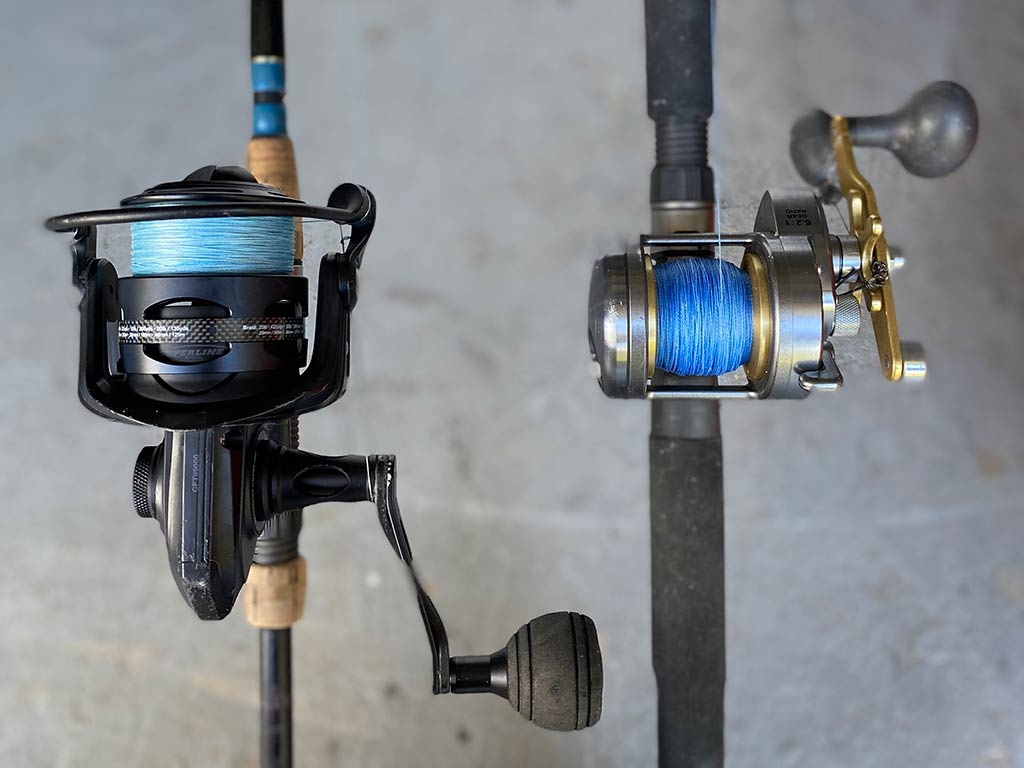
Red Snapper in state waters average 2–10 pounds. In federal waters and deeper habitats, they can grow up to 30 pounds, so plan your tackle accordingly.
For nearshore Red Snapper – in 50 feet or less – a 4000-6000 series spinning reel with a 30 lb braided line is ideal. Most Snapper fishing is done vertically, so you don’t need a long casting rod. Use a stout 6–7′ heavy power boat rod instead. Tie on a 50 lb fluorocarbon leader, a 7/0-10/0 circle hook, and just enough lead to get your bait to the bottom or where the fish are holding (typically 1–3 ounces of weight).
If you’re targeting Red Snapper in deep water around heavy structures such as oil rigs and large artificial reefs, you’ll want to beef up your tackle to contend with strong currents and bigger fish.
A 6000-10000 series spinning reel, or equivalent casting reel with a 50 lb braided line and an 80 lb fluorocarbon leader should do the trick. Use a large non-stainless steel circle hook in the 8/0-12/0 range, and, the deeper you’re fishing, the more lead weight you’ll need.
One of the benefits of hiring an experienced guide or charter boat is that they’ll provide all the tackle, gear, and bait for you.
Best Red Snapper Baits
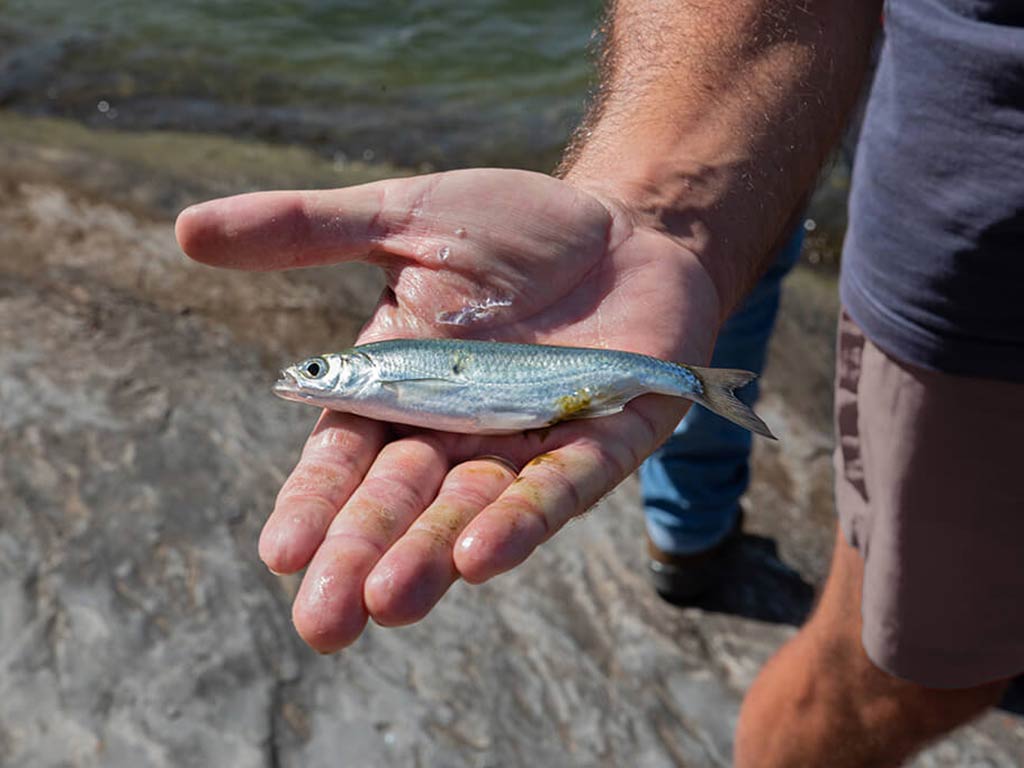
Live Bait
When it comes to the most reliable way to catch Red Snapper, live bait is king. Pinfish, pigfish, pogies, croakers, finger mullet, grunts, cigar minnows, and pilchards all work extremely well. You can try catching your own with a cast net or sabiki rig on any of the coastal navigation buoys, or purchase them in advance at the local marina.
Cut Bait
If you can’t get your hands on any live bait, freshly cut bait is your next option. Chunks of frozen ballyhoo, cigar minnows, squid, and crab can be very effective, especially if you’re able to chum up the Red Snapper into a frenzy. This method works best in waters less than 80 feet deep.
Artificial Bait
Since the vast majority of Red Snapper fishing is done from a vertical position (directly beneath the boat), the most popular lures are vertical pencil jigs or Yo-Yo style lures that are popped up and down vertically with a bright flash and erratic action.
Otherwise, most anglers use heavy-duty jig heads in the 2–5 ounce range, tipped with a piece of cut bait. Simply cast out and let your lure swing 3–6 feet over the structure where the fish are holding. Then, give the rod a few pops, bouncing your jig head up and down while you wait for the bite.
Texas Red Snapper Fishing Regulations
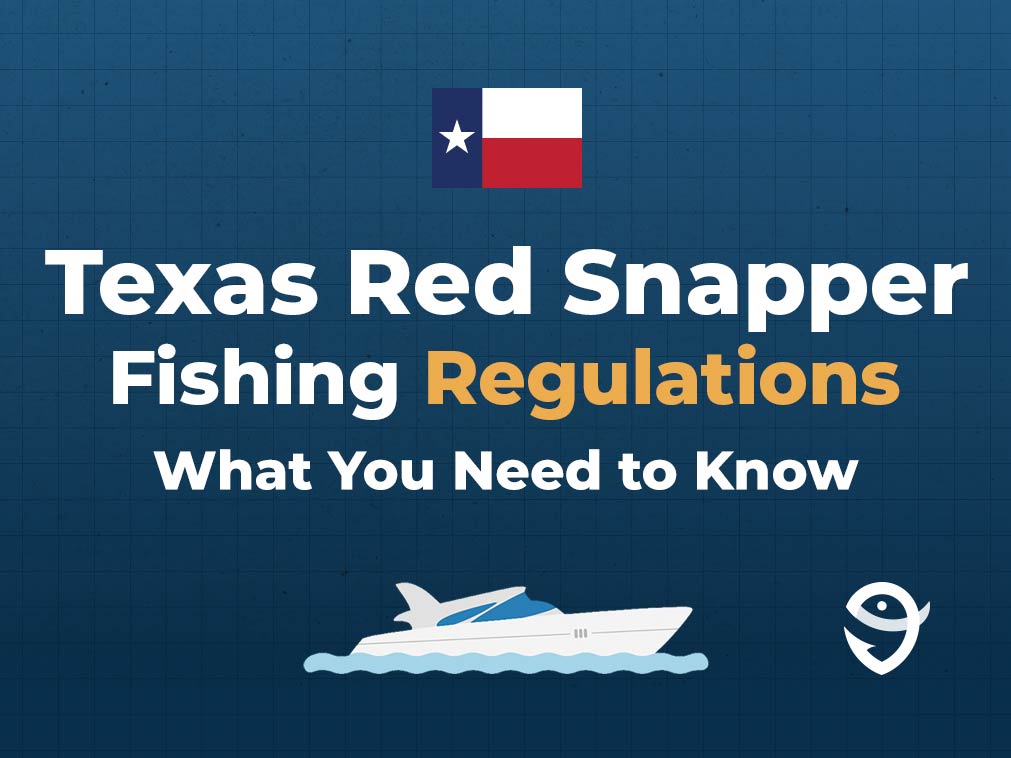
Both resident and non-resident anglers are required to have a valid Texas fishing license with a saltwater endorsement, regardless of whether you’re fishing in state or federal waters. Here are the prices:
Texas Resident Saltwater License Package: $35
Texas Senior Resident Saltwater License Package (age 65+): $17
Non-Resident Saltwater License Package: $63
Red Snapper Fishing In Federal Waters
Season: Opens June 1 –TBD (consult the National Marine Fisheries Service)
Bag Limit: 2 fish per person daily
Size Limit: 16 inch minimum
Red Snapper Fishing in Texas State Waters
Season: Open Year-round*
Bag Limit: 4 fish per person daily
Size limit: 15 inch minimum
*Always consult with the Texas Department of Parks and Wildlife on the most up-to-date Red Snapper regulations, as they can change depending on angler harvest and other environmental conditions.
Gear requirements:
Non-stainless steel circle hooks are required when fishing with natural (live or dead) bait. At least one dehooking device is required per vessel, and must be used to remove hooks.
What else can you catch while Red Snapper fishing?
One of the best parts about fishing for Red Snapper is the mixed bag you’re likely to catch. Mangrove Snapper, Cobia, Amberjack, Triggerfish, Grouper, and many other popular game fish all frequent the same hard relief structure as Red Snapper.
In most cases, anglers are able to catch their limit of red snapper, along with a cooler full of more generous species to fill the freezer.
Texas Red Snapper Fishing: The Best Is in the West

There’s a reason why Red Snapper are among the most desired fish in North America. They taste excellent, they fight hard, and they’re a blast to catch. And Texas offers something that most other states don’t – a year-round season in state waters! That means more opportunity to fill the freezer and catch fish.
Combine this with the fact that there are hundreds of reefs, wrecks, oil rigs, and plenty of natural habitat, and you see why Texas is one of the top spots in the world for Red Snapper. So what are you waiting for? Plan your trip. I assure you won’t regret it!
Have you ever been Red Snapper fishing in Texas? How was your experience? Anything you’d like to share with your fellow anglers? We’d love to hear from you in the comments below!
The post Red Snapper Fishing in Texas appeared first on FishingBooker Blog.
https://ift.tt/pjV9M5m
0 Comments
Enregistrer un commentaire